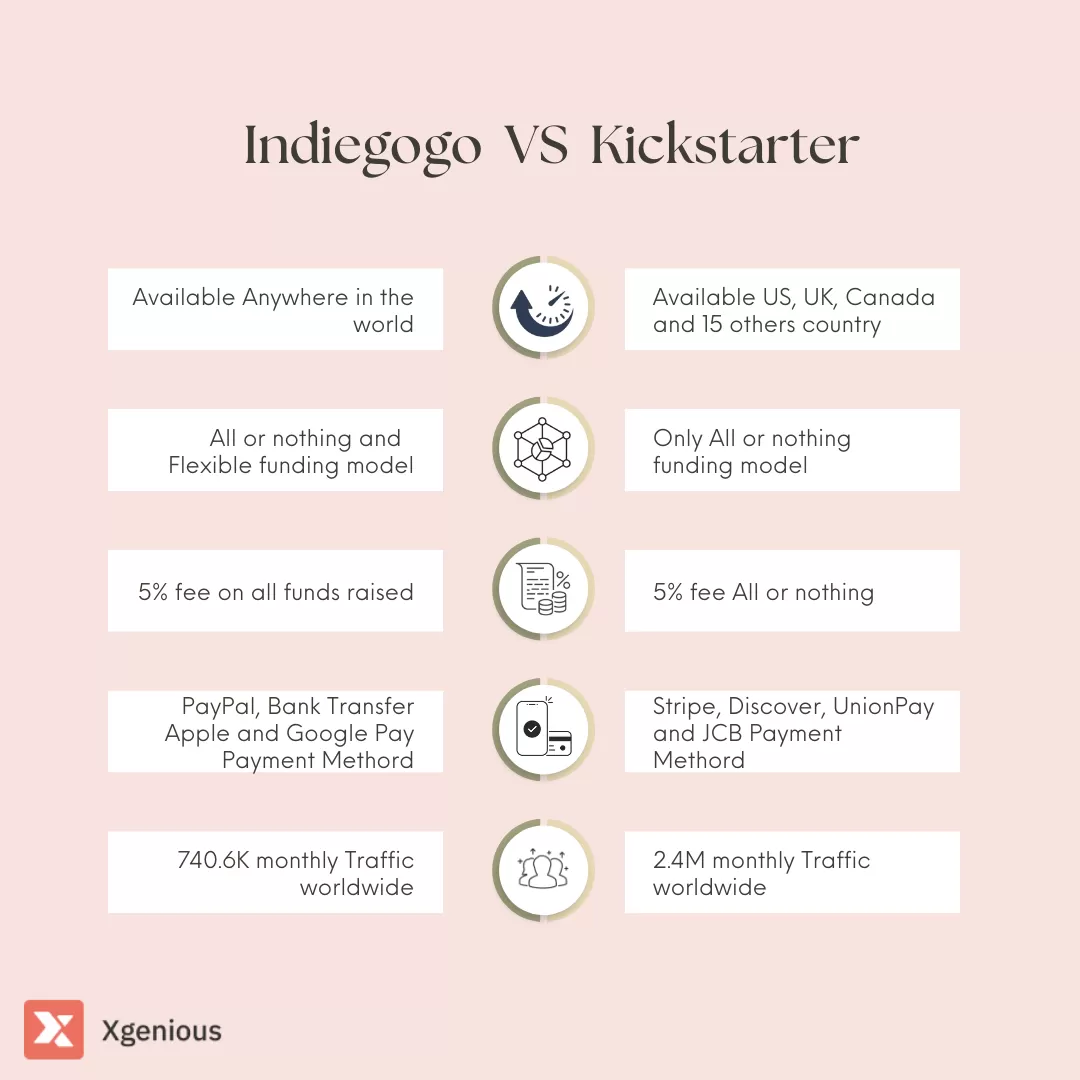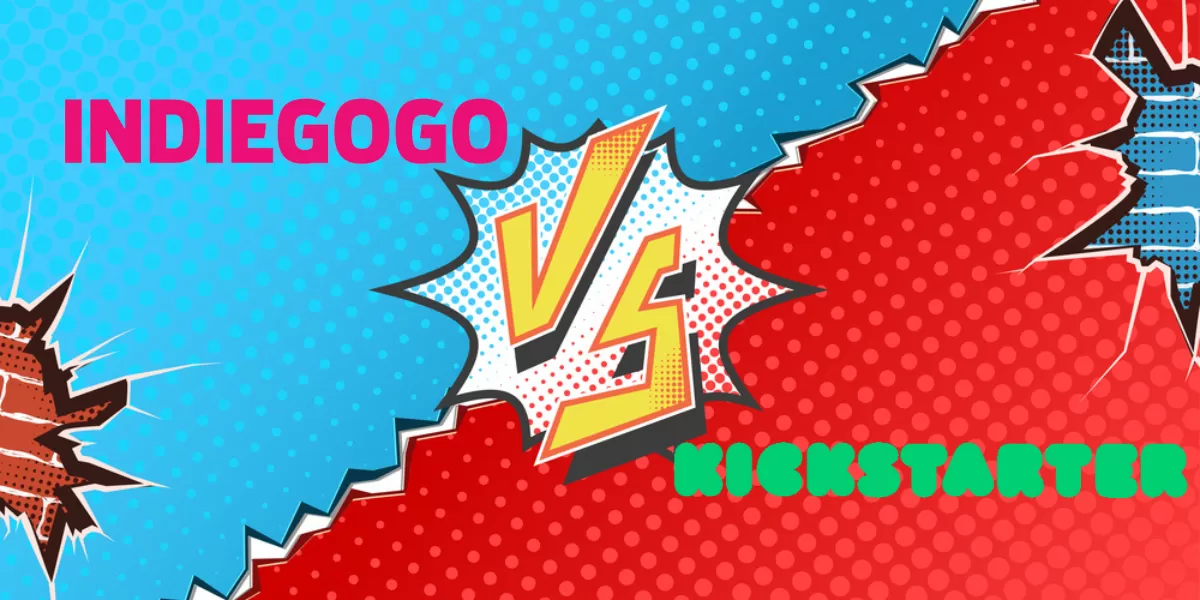Crowdfunding has become increasingly crowded day by day. Today anyone with a great idea can turn to the internet for funding.
With so many options to choose from, it can be tough to know where to go. That’s why we’re here to break down the differences between two of the biggest players in the game: Indiegogo and Kickstarter.
These platforms have been helping entrepreneurs, artists, and innovators for years, but which one is right for your project?
Get ready for a side-by-side showdown, as we explore the key features, success stories, resources etc of Indiegogo vs Kickstarter.
Background Stories of Indiegogo and Kickstarter
Indiegogo and Kickstarter are two of the most well-known crowdfunding platforms in the world. Both platforms were founded in the mid-2000s, with the goal of making it easier for creative minds to bring their ideas to life.
Indiegogo was founded in 2008 and is headquartered in San Francisco. It was one of the first crowdfunding platforms to launch and has since become a global leader in the industry.
Indiegogo allows creators from all over the world to fund their projects, regardless of location or category. The platform offers both flexible and fixed funding options, meaning that creators can keep the funds raised even if they don’t reach their goal.
Kickstarter, on the other hand, was founded in 2009 and is based in New York. The platform operates on an all-or-nothing model, meaning that creators only receive the funds if they reach their funding goal. Kickstarter has a strong focus on creative projects, particularly in the areas of art, design, film, and technology.
Both platforms have seen numerous success stories over the years, with creators raising millions of dollars to bring their ideas to life. However, they each have their own unique approach to crowdfunding and different resources and support options for creators.
Fundamental Difference Between Indiegogo and Kickstarter

Funding Type
Indiegogo is a crowdfunding platform that offers two main funding types for campaigns:
- Flexible Funding: Campaigns can keep all funds raised, regardless of if they reach their goal or not.
- Fixed Funding: Campaigns only receive funds if they reach their goal by the deadline. If the goal is not reached, contributors are not charged and the campaign does not receive any funds.
Note: In some cases, Indiegogo may offer an additional funding type, called “Keep What You Raise,” which is a hybrid of flexible and fixed funding.
Kickstarter is a crowdfunding platform that offers only one funding type for campaigns:
- All or Nothing Funding: Campaigns must reach their goal by the deadline to receive funds. If the goal is not reached, contributors are not charged and the campaign does not receive any funds.
Platform Size
Indiegogo raised 1.5$ billion on their platform. Indiegogo focuses on serviceable products, creative, media, education, transport, etc.
Kickstarter has a bigger platform compared to Indiegogo. Kickstarter launched over 562000 projects and has received pledges worth more than 6.7 billion U.S. dollars as of July 2022. Kickstarter mainly focuses on creative projects.
Unique Monthly Visitors
Indiegogo receives over 739,300 unique visitors per month. With the majority coming from the United States 52%, India accounts for 9.5% of visitors, the United Kingdom for 5.5%, and the rest of the world for 33%. This large audience from diverse geographic locations provides a valuable opportunity for campaign creators to reach potential supporters and funding.
Kickstarter has over 2.4 million unique visitors per month. With the largest portion coming from the United States 43%, The United Kingdom accounts for 6.4% of visitors, Canada for 5%, and the rest of the world for 45.6%.
Note: Because Indiegogo and Kickstarter do not share their real monthly visitors, all the data is coming from SEMRush.
Campaign Apply Process
The campaign creation process for Indiegogo typically involves the following steps:
- Sign up for an Indiegogo account by providing basic information such as your name, email address and password.
- Choose the type of funding, create a campaign page, and provide information about your project, including the goal amount and timeline.
- Customize your campaign page with images, videos and a detailed description of your project. Set perks for contributors.
- Share your campaign with your network and promote it through social media and other marketing channels.
- Monitor the progress of your campaign and engage with contributors. Respond to any questions or concerns they may have.
- If the campaign is successful, Indiegogo will distribute the funds raised, minus their fee, to the campaign creator.
Note: Indiegogo may require additional documentation or information for some campaigns, such as a business plan, prototype, or certifications.
The campaign creation process for Kickstarter typically involves the following steps:
- Sign up for a Kickstarter account by providing basic information such as your name, email address and password.
- Choose the type of funding, create a campaign page, and provide information about your project, including the goal amount and timeline.
- Customize your campaign page with images, videos and a detailed description of your project. Set rewards for backers.
- Submit your campaign for review by Kickstarter. If approved, your campaign will go live on the site.
- Share your campaign with your network and promote it through social media or pitch your project to the press.
Note: Kickstarter has strict guidelines for what is and is not allowed on the platform, and campaigns that violate these guidelines may be rejected.
Payment Process System
Indiegogo partners with Stripe, Paypal, Bank transfer, Apple and Google pay for payment processing. This means that when contributors make a pledge on Indiegogo, their payment information is processed and securely stored by those companies. Campaign creators receive their funds through this after their campaign ends.
Kickstarter Pledge to a project using a debit or credit card from one of the following accepted brands: Visa, Discover, JCB, MasterCard, UnionPay, or American Express. Please note that only US-based projects can currently accept Discover, UnionPay, and JCB cards. Unfortunately, Maestro and Visa Electron cards are not accepted at this time.
If you plan to use a prepaid credit card, ensure that its value is at least 1 USD (or its equivalent in your local currency) higher than your pledge amount to minimize the risk of any pledge collection issues.
Fees Charged
Indiegogo also charges a 5% fee on your raised funds. Their credit card processing fee of 3% plus $0.30 per transaction.
Kickstarter charges a flat 5% platform fee of your total raised funds. If you don’t fill up your target they don’t charge any fee. But if you meet your target you need to withdraw that 5%. Their payment processing fee is between 3%-5%.
Support and Resources
Indiegogo offers a comprehensive support center, including project analytics and marketing tools, to help creators promote their projects and reach their funding goals.
The platform also offers a range of resources, including guides and best practices, to help creators succeed. Additionally, Indiegogo has a thriving community of creators and backers who can provide support and advice throughout the fundraising process.
Kickstarter, on the other hand, offers a well-established community of backers and a wealth of information on successful fundraising strategies. The platform also offers project discovery tools, including featured projects and project categories, to help creators reach their target audience.
Additionally, Kickstarter provides a range of resources and support options to help creators succeed, including information on how to create a compelling campaign, reach your funding goal, and bring your project to life.
Success Rate
According to publicly available data, as of 2021, the estimated success rate for Indiegogo campaigns was around 40-50%. This means that approximately 40-50% of campaigns on Indiegogo reach their funding goal.
According to publicly available data, as of 2021, the estimated success rate for Kickstarter campaigns was around 35-40%. This means that approximately 35-40% of campaigns on Kickstarter reach their funding goal.
Conclusion
In conclusion, Indiegogo and Kickstarter are both highly respected and successful crowdfunding platforms, each offering its own unique features and benefits. Whether you’re looking to bring your creative project to life or to fund a new business idea, both platforms offer a range of support and resources to help you succeed.
When choosing between Indiegogo and Kickstarter, consider your specific needs and goals, as well as the unique features and benefits of each platform. Consider the level of support and resources available, the success rate of funded projects, and the unique angle of each platform to determine which is the best fit for your project.
Ultimately, the key to success on either platform is to be well-prepared, have a clear plan, and put in the effort to reach your funding goal. With the right preparation and effort, either Indiegogo or Kickstarter can help you bring your project to life and make your dreams a reality.
